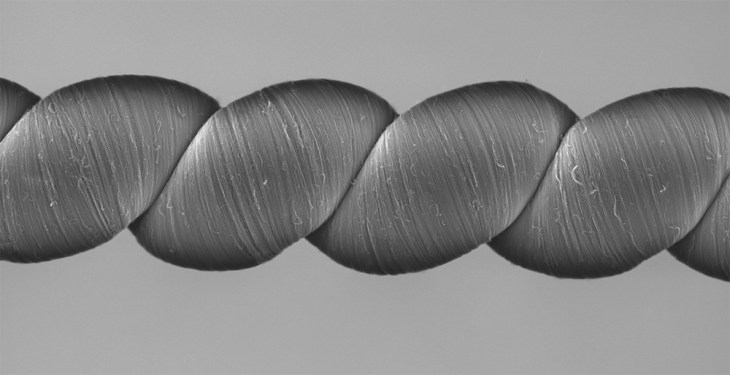Everyone wants smart clothes, but no one wants to wear a battery pack. Truly a first-world problem. But that doesn’t mean a solution can’t be interesting. Researchers at the University of Texas, Dallas have created a power-generating yarn from woven carbon nanotubes, and given it an amazing name: twistron.
Of course, there are plenty of piezoelectric materials out there that generate power when stretched or compressed. But this twistron yarn is strong, flexible and acts as a supercapacitor to boot. The ultra-thin carbon nanotubes that compose them are twisted and coiled to provide the stretch, conductivity and other desirable qualities.
“Electronic textiles are of major commercial interest, but how are you going to power them?” asked Ray Baughman, head UT Dallas’s NanoTech Institute, in a news release. “Harvesting electrical energy from human motion is one strategy for eliminating the need for batteries. Our yarns produced over a hundred times higher electrical power per weight when stretched compared to other weavable fibers reported in the literature.”
It’s not a lot — fractions of a watt per milligram of the stuff — but power requirements are low for embedded tech. So what’s the catch?
Well, the thing is, the twistron needs to be soaked in electrolytes to work. But while that could conceivably be your sweat, it definitely doesn’t have to be. In fact, in the paper the team published in Science, they describe a solid-state electrolyte — a sort of salty polymer — that encapsulates the twistron and lets it generate power without being bathed in the stuff.
To test that type of twistron, the researchers wove the yarns into a shirt, and it generated small but usable amounts of electricity just from the wearer’s respiration. For low-power devices woven in, like for example wireless transceiver that only needs to send out a burst every few minutes, this trickle of power would be more than enough.
Another use case they tested was motion in the ocean. One of the lead authors, Shi Hyeong Kim, attached a balloon to a weight with twistron yarn and deposited it in the salty surf of South Korea himself. Wave action caused the line to move and stretch — generating electricity. This could easily be scaled, and may be a unique and easily customized way to pull power from the sea.
“If our twistron harvesters could be made less expensively, they might ultimately be able to harvest the enormous amount of energy available from ocean waves,” Baughman said.
The team has patented the tech and is looking into applications, but as with most cool technologies like this, it’ll be a while before we see it in action. In the meantime, feel free to browse the NanoTech Institute’s other fascinating projects here.
